Controlled Mechanical Cracking of Metal Films Deposited on Polydimethylsiloxane (PDMS)
Abstract
:1. Introduction
2. Results
2.1. Cracking of the UV Hardened PDMS Surface
2.2. Cracking of the Silver Film on Top of the Hardened PDMS
3. Discussion
4. Materials and Methods
4.1. Sample Preparation
4.2. Electroless Deposition
4.3. Stretching Experiments
Acknowledgments
Author Contributions
Conflicts of Interest
Abbreviations
| PDMS | polydimethylsiloxane |
| UV | ultraviolet |
| ELD | electroless deposition |
References
- Rogers, J.A.; Someya, T.; Huang, Y.G. Materials and mechanics for stretchable electronics. Science 2010, 327, 1603–1607. [Google Scholar] [CrossRef] [PubMed]
- Kim, D.H.; Lu, N.S.; Huang, Y.G.; Rogers, J.A. Materials for stretchable electronics in bioinspired and biointegrated devices. MRS Bull. 2012, 37, 226–235. [Google Scholar] [CrossRef]
- Ko, H.C.; Stoykovich, M.P.; Song, J.Z.; Malyarchuk, V.; Choi, W.M.; Yu, C.J.; Geddes, J.B.; Xiao, J.L.; Wang, S.D.; Huang, Y.G.; et al. A hemispherical electronic eye camera based on compressible silicon optoelectronics. Nature 2008, 454, 748–753. [Google Scholar] [CrossRef] [PubMed]
- Görrn, P.; Lehnhardt, M.; Kowalsky, W.; Riedl, T.; Wagner, S. Elastically tunable self-organized organic lasers. Adv. Mater. 2011, 23, 869–872. [Google Scholar] [CrossRef] [PubMed]
- Gutruf, P.; Zeller, E.; Walia, S.; Sriram, S.; Bhaskaran, M. Mechanically tunable high refractive-index contrast TiO2-pdms gratings. Adv. Opt. Mater. 2015, 3, 1565–1569. [Google Scholar] [CrossRef]
- Gutruf, P.; Zou, C.J.; Withayachumnankul, W.; Bhaskaran, M.; Sriram, S.; Fumeaux, C. Mechanically tunable dielectric resonator metasurfaces at visible frequencies. ACS Nano 2015, 10, 133–141. [Google Scholar] [CrossRef] [PubMed]
- Sekitani, T.; Nakajima, H.; Maeda, H.; Fukushima, T.; Aida, T.; Hata, K.; Someya, T. Stretchable active-matrix organic light-emitting diode display using printable elastic conductors. Nat. Mater. 2009, 8, 494–499. [Google Scholar] [CrossRef] [PubMed]
- Lipomi, D.J.; Tee, B.C.K.; Vosgueritchian, M.; Bao, Z.N. Stretchable organic solar cells. Adv. Mater. 2011, 23, 1771–1775. [Google Scholar] [CrossRef] [PubMed]
- Lipomi, D.J.; Vosgueritchian, M.; Tee, B.C.K.; Hellstrom, S.L.; Lee, J.A.; Fox, C.H.; Bao, Z.N. Skin-like pressure and strain sensors based on transparent elastic films of carbon nanotubes. Nat. Nanotechnol. 2011, 6, 788–792. [Google Scholar] [CrossRef] [PubMed]
- Minev, I.R.; Musienko, P.; Hirsch, A.; Barraud, Q.; Wenger, N.; Moraud, E.M.; Gandar, J.; Capogrosso, M.; Milekovic, T.; Asboth, L.; et al. Electronic dura mater for long-term multimodal neural interfaces. Science 2015, 347, 159–163. [Google Scholar] [CrossRef] [PubMed]
- Lee, P.; Lee, J.; Lee, H.; Yeo, J.; Hong, S.; Nam, K.H.; Lee, D.; Lee, S.S.; Ko, S.H. Highly stretchable and highly conductive metal electrode by very long metal nanowire percolation network. Adv. Mater. 2012, 24, 3326–3332. [Google Scholar] [CrossRef] [PubMed]
- Rosset, S.; Niklaus, M.; Dubois, P.; Shea, H.R. Metal ion implantation for the fabrication of stretchable electrodes on elastomers. Adv. Funct. Mater. 2009, 19, 470–478. [Google Scholar] [CrossRef]
- Lacour, S.P.; Jones, J.; Wagner, S.; Li, T.; Suo, Z.G. Stretchable interconnects for elastic electronic surfaces. Proc. IEEE 2005, 93, 1459–1467. [Google Scholar] [CrossRef]
- Wagner, S.; Bauer, S. Materials for stretchable electronics. MRS Bull. 2012, 37, 207–217. [Google Scholar] [CrossRef]
- Gray, D.S.; Tien, J.; Chen, C.S. High-conductivity elastomeric electronics. Adv. Mater. 2004, 16, 393–397. [Google Scholar] [CrossRef]
- Lee, J.N.; Park, C.; Whitesides, G.M. Solvent compatibility of poly(dimethylsiloxane)-based microfluidic devices. Anal. Chem. 2003, 75, 6544–6554. [Google Scholar] [CrossRef] [PubMed]
- Bowden, N.; Brittain, S.; Evans, A.G.; Hutchinson, J.W.; Whitesides, G.M. Spontaneous formation of ordered structures in thin films of metals supported on an elastomeric polymer. Nature 1998, 393, 146–149. [Google Scholar]
- Bowden, N.; Huck, W.T.S.; Paul, K.E.; Whitesides, G.M. The controlled formation of ordered, sinusoidal structures by plasma oxidation of an elastomeric polymer. Appl. Phys. Lett. 1999, 75, 2557–2559. [Google Scholar] [CrossRef]
- Görrn, P.; Wagner, S. Topographies of plasma-hardened surfaces of poly(dimethylsiloxane). J. Appl. Phys. 2010, 108, 093522. [Google Scholar] [CrossRef]
- Görrn, P.; Cao, W.Z.; Wagner, S. Isotropically stretchable gold conductors on elastomeric substrates. Soft Matter 2011, 7, 7177–7180. [Google Scholar] [CrossRef]
- Polywka, A.; Jakob, T.; Stegers, L.; Riedl, T.; Görrn, P. Facile preparation of high-performance elastically stretchable interconnects. Adv. Mater. 2015, 27, 3755–3759. [Google Scholar] [CrossRef] [PubMed]
- Choi, W.M.; Song, J.Z.; Khang, D.Y.; Jiang, H.Q.; Huang, Y.Y.; Rogers, J.A. Biaxially stretchable “wavy” silicon nanomembranes. Nano Lett. 2007, 7, 1655–1663. [Google Scholar] [CrossRef] [PubMed]
- Seghir, R.; Arscott, S. Controlled mud-crack patterning and self-organized cracking of polydimethylsiloxane elastomer surfaces. Sci. Rep. 2015, 5, 14787. [Google Scholar] [CrossRef] [PubMed]
- Mills, K.L.; Huh, D.; Takayama, S.; Thouless, M.D. Instantaneous fabrication of arrays of normally closed, adjustable, and reversible nanochannels by tunnel cracking. Lab Chip 2010, 10, 1627–1630. [Google Scholar] [CrossRef] [PubMed]
- Gutruf, P.; Shah, C.M.; Walia, S.; Nili, H.; Zoolfakar, A.S.; Karnutsch, C.; Kalantar-zadeh, K.; Sriram, S.; Bhaskaran, M. Transparent functional oxide stretchable electronics: Micro-tectonics enabled high strain electrodes. NPG Asia Mater. 2013, 5, e62. [Google Scholar] [CrossRef]
- Nam, K.H.; Park, I.H.; Ko, S.H. Patterning by controlled cracking. Nature 2012, 485, 221–224. [Google Scholar] [CrossRef] [PubMed]
- Kim, B.C.; Matsuoka, T.; Moraes, C.; Huang, J.X.; Thouless, M.D.; Takayama, S. Guided fracture of films on soft substrates to create micro/nano-feature arrays with controlled periodicity. Sci. Rep. 2013, 3, 3027. [Google Scholar] [CrossRef] [PubMed]
- Kim, B.C.; Moraes, C.; Huang, J.X.; Thouless, M.D.; Takayama, S. Fracture-based micro- and nanofabrication for biological applications. Biomater. Sci. 2014, 2, 288–296. [Google Scholar] [CrossRef] [PubMed][Green Version]
- Thouless, M.D. Crack spacing in brittle films on elastic substrates. J. Am. Ceram. Soc. 1990, 73, 2144–2146. [Google Scholar] [CrossRef]
- Shenoy, V.B.; Schwartzman, A.F.; Freund, L.B. Crack patterns in brittle thin films. Int. J. Fract. 2000, 103, 1–17. [Google Scholar] [CrossRef]
- Huang, H.B.; Spaepen, F. Tensile testing of free-standing cu, ag and al thin films and ag/cu multilayers. Acta Mater. 2000, 48, 3261–3269. [Google Scholar] [CrossRef]
- Jakob, T.; Polywka, A.; Stegers, L.; Akdeniz, E.; Kropp, S.; Frorath, M.; Trost, S.; Schneider, T.; Riedl, T.; Görrn, P. Transfer printing of electrodes for organic devices: Nanoscale versus macroscale continuity. Appl. Phys. A Mater. 2015, 120, 503–508. [Google Scholar] [CrossRef]
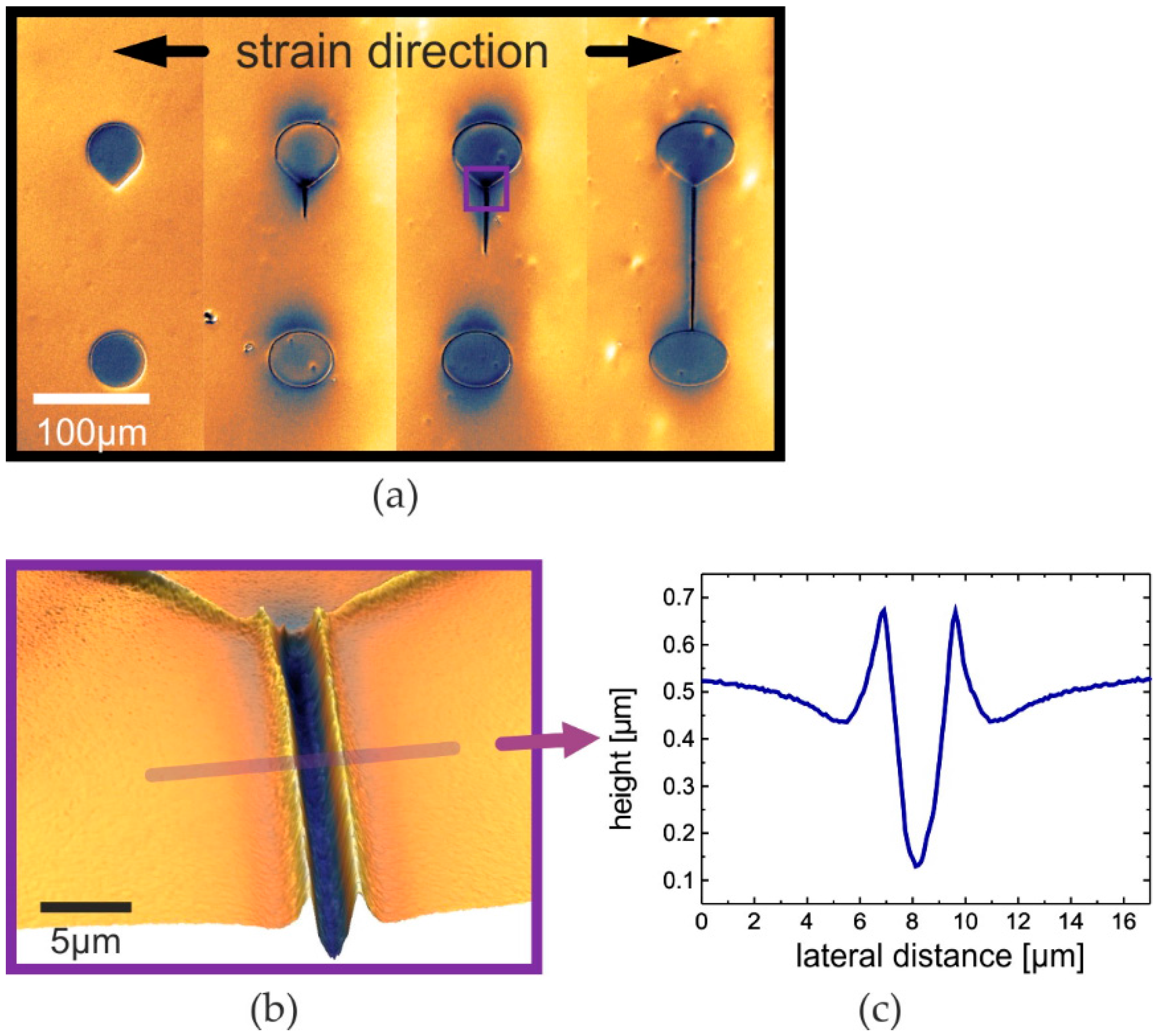
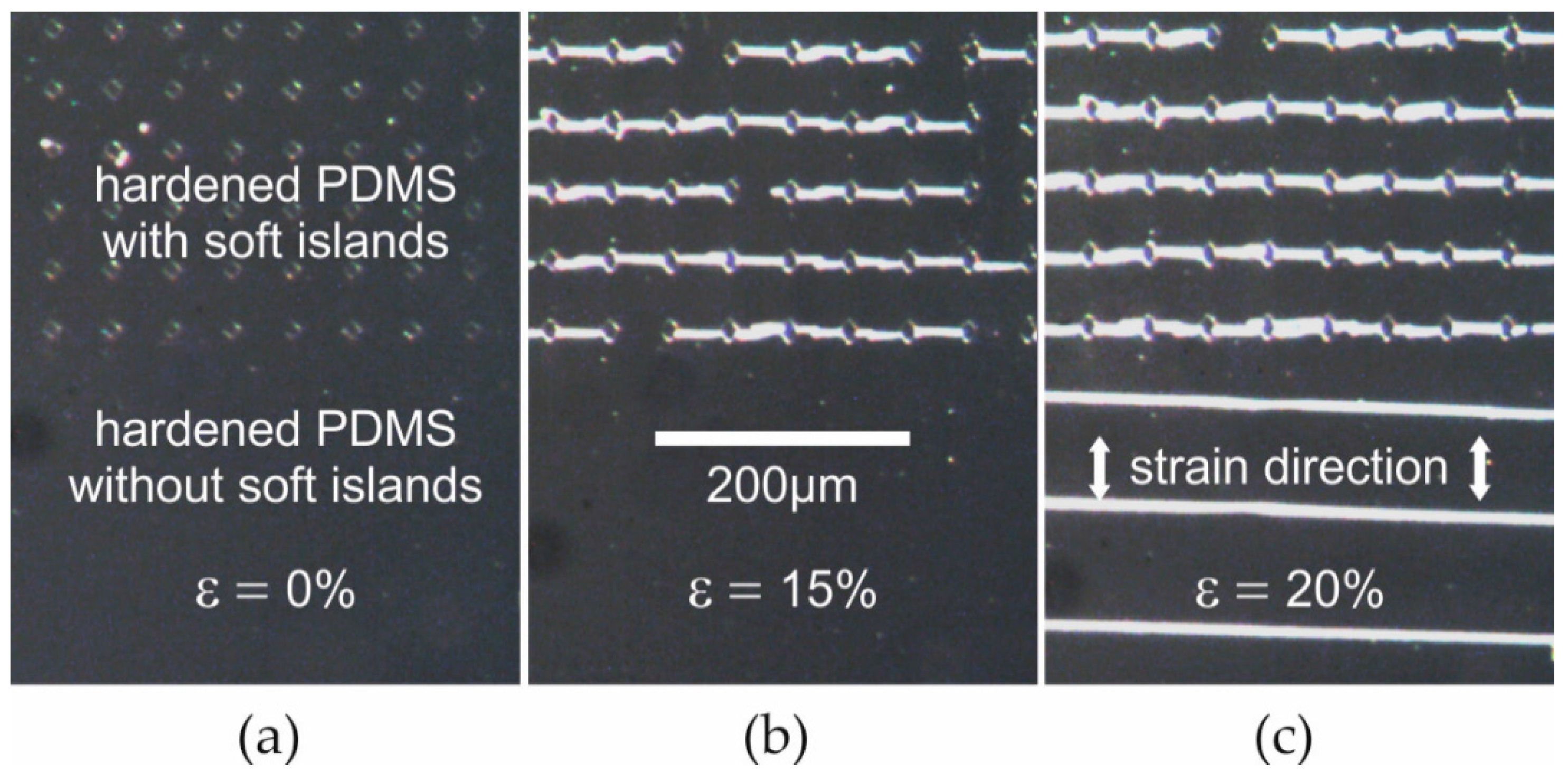
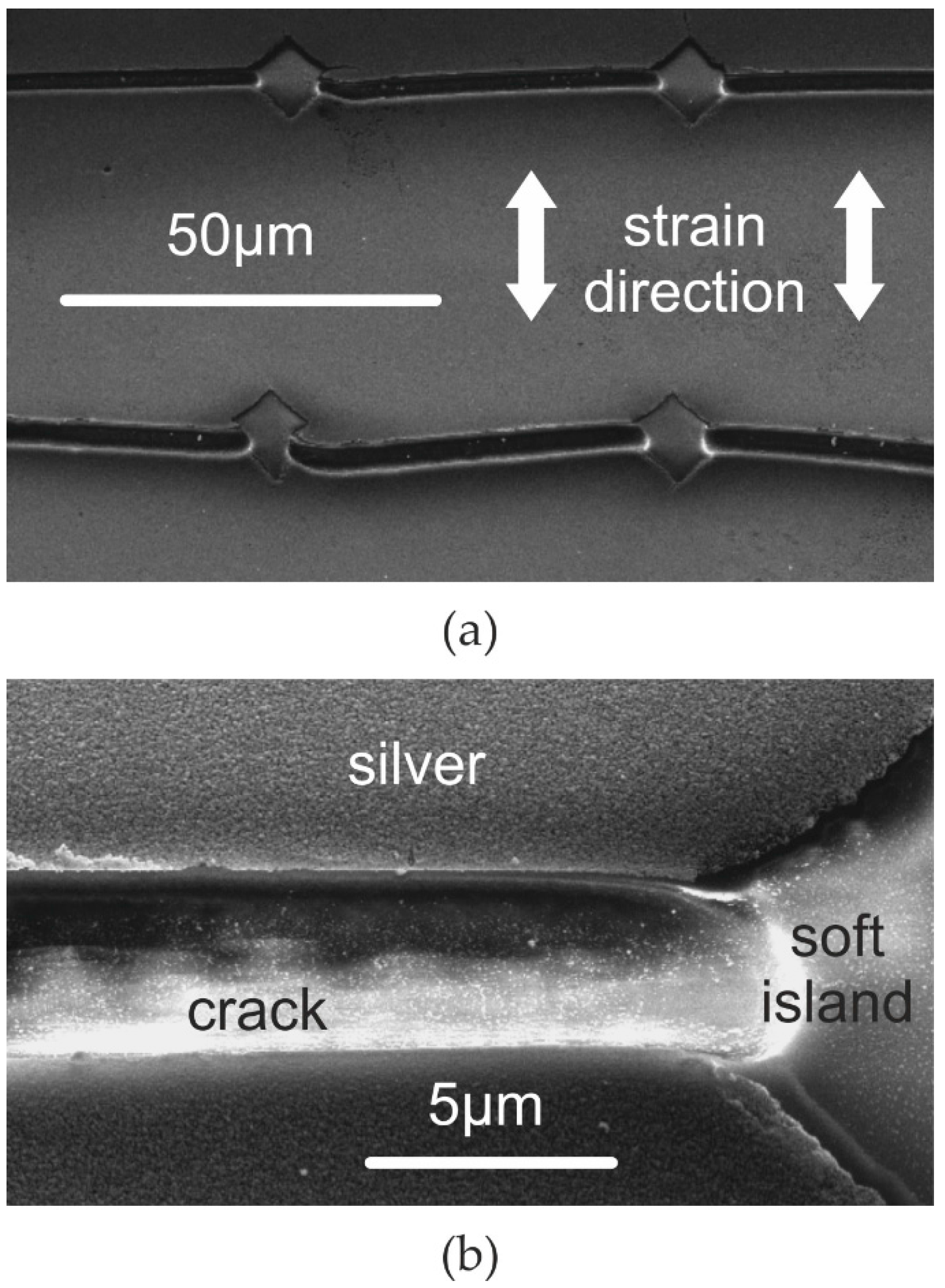
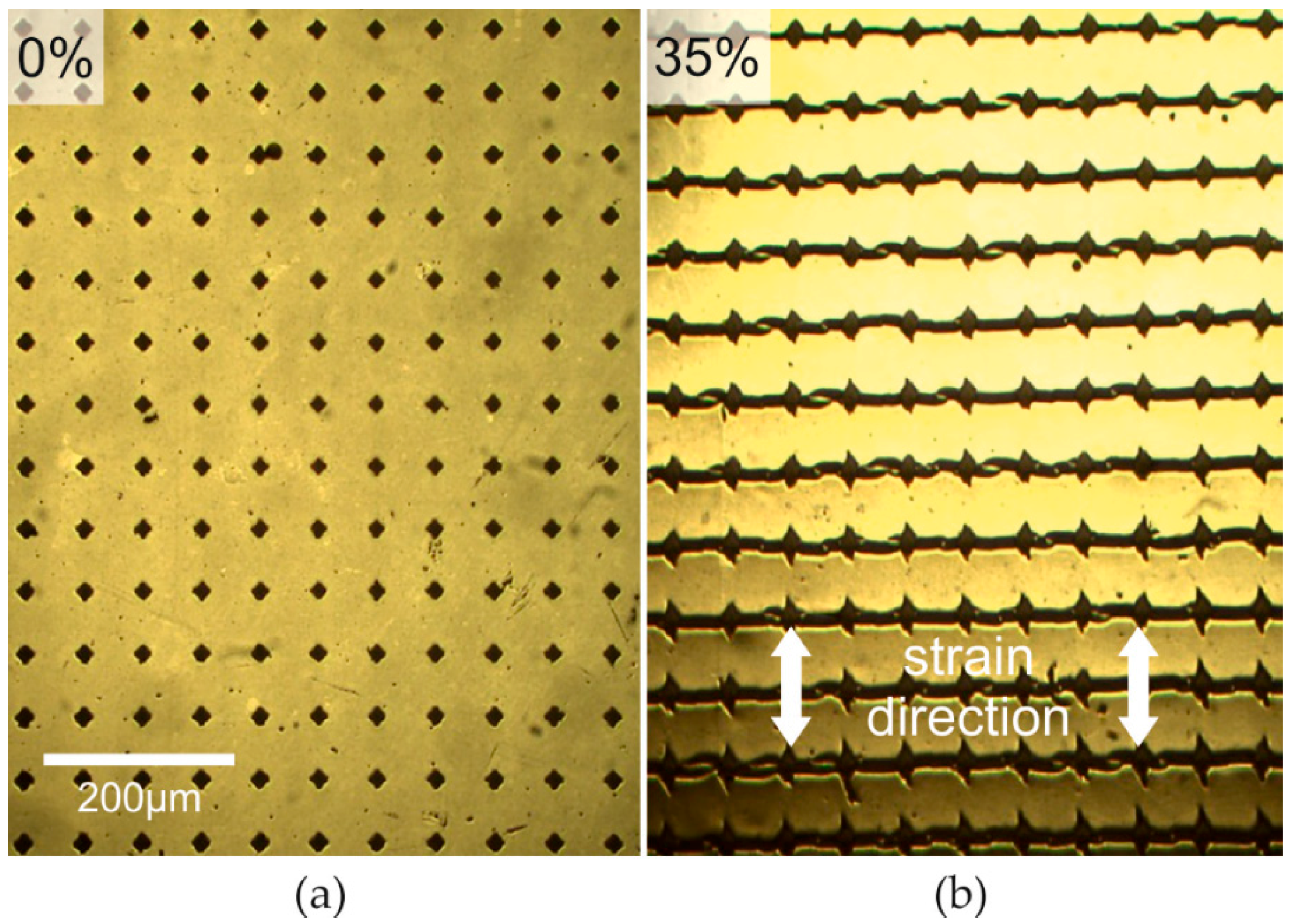
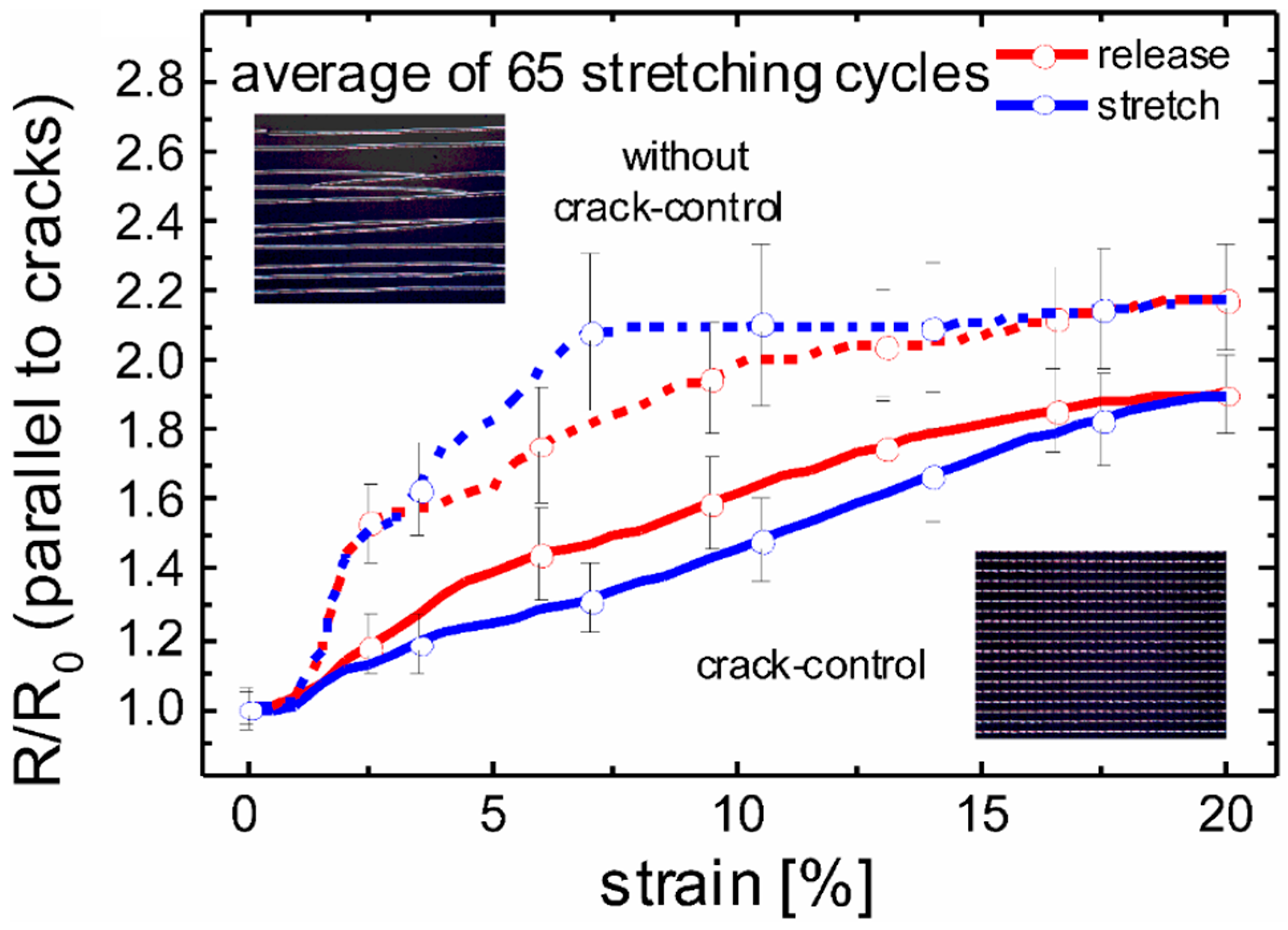
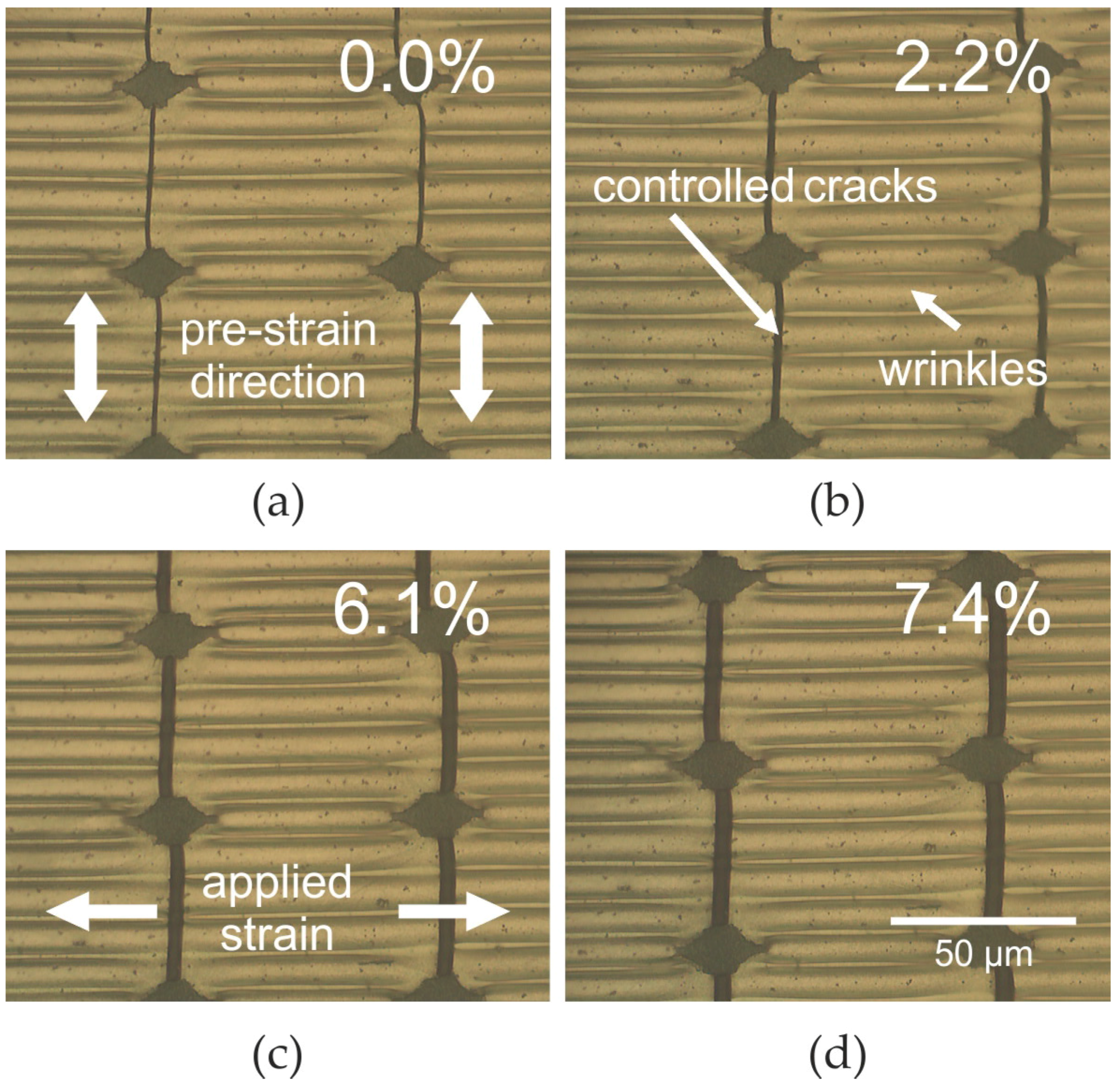
© 2016 by the authors; licensee MDPI, Basel, Switzerland. This article is an open access article distributed under the terms and conditions of the Creative Commons Attribution (CC-BY) license (http://creativecommons.org/licenses/by/4.0/).
Share and Cite
Polywka, A.; Stegers, L.; Krauledat, O.; Riedl, T.; Jakob, T.; Görrn, P. Controlled Mechanical Cracking of Metal Films Deposited on Polydimethylsiloxane (PDMS). Nanomaterials 2016, 6, 168. https://doi.org/10.3390/nano6090168
Polywka A, Stegers L, Krauledat O, Riedl T, Jakob T, Görrn P. Controlled Mechanical Cracking of Metal Films Deposited on Polydimethylsiloxane (PDMS). Nanomaterials. 2016; 6(9):168. https://doi.org/10.3390/nano6090168
Chicago/Turabian StylePolywka, Andreas, Luca Stegers, Oliver Krauledat, Thomas Riedl, Timo Jakob, and Patrick Görrn. 2016. "Controlled Mechanical Cracking of Metal Films Deposited on Polydimethylsiloxane (PDMS)" Nanomaterials 6, no. 9: 168. https://doi.org/10.3390/nano6090168
APA StylePolywka, A., Stegers, L., Krauledat, O., Riedl, T., Jakob, T., & Görrn, P. (2016). Controlled Mechanical Cracking of Metal Films Deposited on Polydimethylsiloxane (PDMS). Nanomaterials, 6(9), 168. https://doi.org/10.3390/nano6090168





